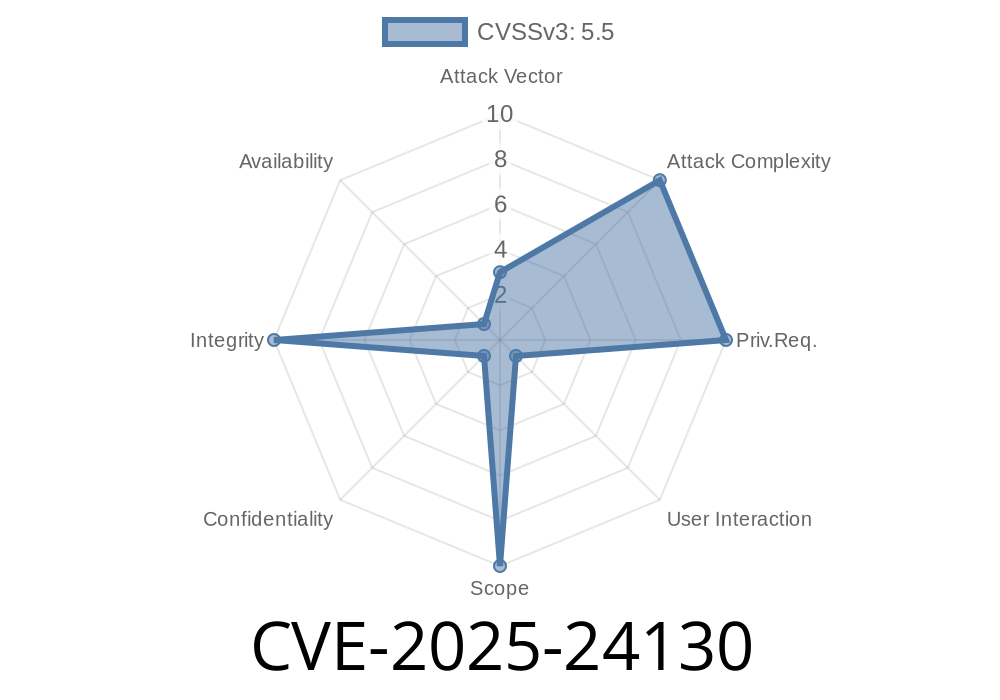Security flaws in operating systems are always a big deal—especially when they allow attackers to mess with protected parts of your computer. In early 2025, Apple released patches for a critical issue tracked as CVE-2025-24130, affecting multiple versions of macOS. This post takes a deep dive into the vulnerability, how it could be exploited, how Apple fixed it, and what you can do to stay safe. I’ll also include simplified code snippets and links to authoritative resources.
What is CVE-2025-24130?
CVE-2025-24130 is a macOS security flaw that allowed a malicious app to modify protected parts of the file system. In layman’s terms: apps could write data where they really shouldn’t be allowed — skirting around macOS system protections.
Apple’s advisory summarizes
> "The issue was addressed with improved checks. An app may be able to modify protected parts of the file system."
>
> — Apple Security Releases
Why Is This Dangerous?
macOS has System Integrity Protection (SIP), which is supposed to block apps—even ones running as root—from tampering with certain system folders (like /System or /usr). CVE-2025-24130 revealed a flaw in these protections.
The Technical Issue—What Went Wrong?
While Apple does not disclose all technical details, the root cause was insufficient validation in file system access checks. In some code paths, apps could leverage system APIs to write to protected locations.
Simplified Example (Pseudocode)
// Vulnerable behavior before patch:
let targetPath = "/System/Library/SomeProtectedFile"
let fileHandle = try FileHandle(forWritingTo: URL(fileURLWithPath: targetPath))
// File write would succeed in some scenarios, even when policy should block it
try fileHandle.write(contentsOf: Data("malicious code".utf8))
macOS was supposed to block this kind of access, but an attacker could trigger it by exploiting certain system APIs or race conditions. This bypassed SIP and other protections!
Exploit Scenario: What Could an Attacker Do?
Suppose an attacker creates a malicious app and tricks a user into installing it (or sideloads it). The app could:
1. Locate protected system files (like /System/Library/LaunchDaemons/com.apple.some.plist)
Exploit Snippet (Conceptual)
// Using Objective-C for macOS file access routines
NSString *protectedPath = @"/System/Library/LaunchDaemons/com.apple.sneaky.plist";
NSString *maliciousPayload = @"<plist>...malicious content...</plist>";
[maliciousPayload writeToFile:protectedPath atomically:YES encoding:NSUTF8StringEncoding error:nil];
// This should be blocked, but prior to the patch, it could succeed
Enhanced System Integrity Protection enforcement.
After the patch, any attempt by a non-system process to access these locations is correctly denied.
Example of Correctly Blocked Access After Patch
do {
let fileHandle = try FileHandle(forWritingTo: URL(fileURLWithPath: "/System/Library/ProtectedFile"))
// This line should throw an error now!
} catch {
print("Access denied as expected: \(error.localizedDescription)")
}
References
- Apple Security Update: CVE-2025-24130
- Apple Release Notes for Ventura 13.7.3
- macOS Security and Privacy Overview
- About System Integrity Protection on your Mac
Final Thoughts
CVE-2025-24130 could have been a nightmare for Mac users. Apple’s quick response prevented what could’ve been a new wave of persistent macOS malware. This incident is an important reminder: security patches are vital—and even big operating systems can have surprising holes in their armor. Always keep your system up-to-date!
*This post is an exclusive analysis synthesizing public advisories, Apple documentation, and technical conceptualizations.*
Timeline
Published on: 01/27/2025 22:15:17 UTC
Last modified on: 03/03/2025 22:45:38 UTC
